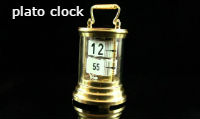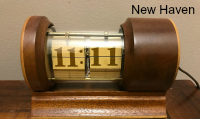 While advertisements for flip clocks and especially flip clock radios exploded between 1970 and 1975, there were almost none prior to the 70s. None except for this little, simple yet elegant flip clock called the Caslon 201.
While advertisements for flip clocks and especially flip clock radios exploded between 1970 and 1975, there were almost none prior to the 70s. None except for this little, simple yet elegant flip clock called the Caslon 201. While there were other first tries (the Caslon 101) it was the model 201 that seems to have made the first appearance in newspapers as early as 1966! This was the same year that the famous Solari Udine Cifra 3 was released! This surprised me, as I didn't think the Japanese invasion of flip clocks happened until the 1970s.
Now, it must be emphasized that technically, these were not the first flip clocks. Not counting the grandfather of flip clocks (the Plato Clock circa 1904) there existed two wonderful art deco clocks from the late 1930s called the New Haven "Stylis Timepiece" and the "Perseus Numeral Timepiece" (pictured) - both curiously with the same model number: N.H.S 611-247T.
Those new to flip clocks must ask themselves, so, what's the big deal then? The Solari Udine Cifra 3
 caused much excitment when it was featured in the Museum of Modern Art (MOMA) in New York, in the "Humble Masterpieces" collection, not long after it was released to the public. Some seem to get the impression that the Cifra 3 was the first flip clock, or the "Holy Grail of Flip Clocks" (whatever that means). In fact, some go so far as to claim it is the best clock design of all time. Perhaps, these are people trying to sell their Cifra 3. In any event, as we've already seen, it definitely was not the first flip clock. But maybe, as I believe, it was the one that spurred the modern flip clock craze of the 1970s. Specifically, it was around this time that the company Copal Japan mastered making the flip clock mechanisms and began producing the clocks that caught the attention of the US buying public. As we know, the vast majority of our flip clocks have Japanese Copal mechanisms.
caused much excitment when it was featured in the Museum of Modern Art (MOMA) in New York, in the "Humble Masterpieces" collection, not long after it was released to the public. Some seem to get the impression that the Cifra 3 was the first flip clock, or the "Holy Grail of Flip Clocks" (whatever that means). In fact, some go so far as to claim it is the best clock design of all time. Perhaps, these are people trying to sell their Cifra 3. In any event, as we've already seen, it definitely was not the first flip clock. But maybe, as I believe, it was the one that spurred the modern flip clock craze of the 1970s. Specifically, it was around this time that the company Copal Japan mastered making the flip clock mechanisms and began producing the clocks that caught the attention of the US buying public. As we know, the vast majority of our flip clocks have Japanese Copal mechanisms.And that brings us right back to the Caslon 201. A glowing Caslon 201 advertisement can also be found in the pages of the May 13, 1967 issue of "Science News" where it was introduced as "A different kind of time." (see below for image and text of this advertisement). Reading the newspaper advertisements of the day, you get the feel that is was a big deal and the next big thing. The late 60s was the beginning of the "Space Age" and often you'll see references to these flip clocks as "Excitingly Unique," "space age clocks" or "computer age clocks of tomorrow." It's funny now, because they had no idea that electronic digital would eclipse the flip clock by the 1980s. But looking at the sheer volume of ads for the Caslon 201 (and other models that followed) it is clear that the 1970s was the decade of the flip clock (and flip clock radios), and that the Caslon 201 seems to have led the pack.
Clock Details
The clock was advertised as using Cyclolac for the body (billed as "same as used for telephones”). This is very durable and shatter resistant plastic. The clock face is real glass held in place by a real metal chrome bezel. The mechanism consists of white vinal tiles with black numbers run by a "Copal II" synchronous motor pushing gears housed in a sealed metal case. The clock is lit by a neon glow bulb and was said to glow in the dark "like a princess phone" (these telephones were a huge hit in the 50s and 60s due to their feature of lighting up). As already mentioned, it appeared in print ads in 1966 and then disappeared after 1973.
Summary:
It surprises me that there are not more of these clocks showing up on Etsy or Ebay. To me, it seems that they should be more abundant. Also I would think that they would be more desirable to collectors than other clocks. But that's where flip clockery didn't take that left turn at Albuquerque. People collect flip clocks for many varied reasons. Some collect clocks that have appeared on TV or in the movies (guilty here), others seek out specific brands (Panasonic, Sony) and still others just want the clock that they had as a kid.
But as far as flip clock history, I feel the Caslon 201 earned it's spot as the trail blazer in the US market. Not only does it deserve a spot on the shelf of any collector of clocks just because of its historical significance, it's just simply, one nice little flip clock!
Advertisement from 1967:

(text of the above ad follows)
This Kind of Clock Tells A Different Kind of Time.
It even glows in the dark ... like a Princess phone.
This is just time you say? Well read how this Caslon Clock will change the way you read it.
It's a psychological fact (try it on friends) that when people look away from an ordinary clock (one with hands!), they seldom remember the exact time. They know about what time it is. This is because most often you just glance at a clock to orient yourself to the time ... in relationship to some upcoming moment, date, event or whatever. But. When you glance away from this digital timepiece and someone asks you the time: you'll tive it exactly. Right to the minute. "It is 3:43". That's the difference between seeing all 12 hours at once and this "digital readout" that states the precise time, and only the precise time.
The numbers of this plug-in electric clock can be read at a good 50-paces. A silent motor flips the plastic into view faster that the eye can see. One second it's 3:43 and then, suddenly, it's 3:44. Don't worry. The change is silent. net even a "click".
This improved way of telling time is the 110V Caslon 201 digital electric table clock. It that sounds like a mouthful you should see it in 3-dimensional color. It's an eyeful. Beautiful, in the modern manner. The console shape is at home with any decor, in any room - or office. You have a choice of six colors (see coupon) to complement your furnishings. But most important, the Caslon 201 tells time in a way you can't mistake - won't forget! It is something of a conversation piece, too. People will stand there staring at it, waiting, trying to catch it change time. But it is faster than a wink, and quieter than your wristwatch. (The precise synchronous motor is of the hysteresis type - with 18 poles - operating a a low speed to assure even, silent operation and a good long life.). Dimensions: 5 1/2" x 3 1/2" X 3 1/2".
P.S. A beautiful gift - the kind you'd love to receive
Take Time - Order Now
Mail to: Haverhill's
526 Washington St., San Francisco Calif. 94111.
Please mail me the 110V Caslon 201 digital electric table clock
I enclose $24.90 plus $1.00 for Post & Ins.
Satisfaction or refund guaranteed.
(California Residents Add 4% Sales Tax)
Am. Expr. Acct. # ___________
Underline your color:
Snowwhite Charcoal Red-Red Airline Blue Weatglo Deep-Night
© 1965 Haverhill's SN-0513
Searching the World to bring you the Finest
From Science News / VOl. 91 / 13 May 1967
It even glows in the dark ... like a Princess phone.
This is just time you say? Well read how this Caslon Clock will change the way you read it.
It's a psychological fact (try it on friends) that when people look away from an ordinary clock (one with hands!), they seldom remember the exact time. They know about what time it is. This is because most often you just glance at a clock to orient yourself to the time ... in relationship to some upcoming moment, date, event or whatever. But. When you glance away from this digital timepiece and someone asks you the time: you'll tive it exactly. Right to the minute. "It is 3:43". That's the difference between seeing all 12 hours at once and this "digital readout" that states the precise time, and only the precise time.
The numbers of this plug-in electric clock can be read at a good 50-paces. A silent motor flips the plastic into view faster that the eye can see. One second it's 3:43 and then, suddenly, it's 3:44. Don't worry. The change is silent. net even a "click".
This improved way of telling time is the 110V Caslon 201 digital electric table clock. It that sounds like a mouthful you should see it in 3-dimensional color. It's an eyeful. Beautiful, in the modern manner. The console shape is at home with any decor, in any room - or office. You have a choice of six colors (see coupon) to complement your furnishings. But most important, the Caslon 201 tells time in a way you can't mistake - won't forget! It is something of a conversation piece, too. People will stand there staring at it, waiting, trying to catch it change time. But it is faster than a wink, and quieter than your wristwatch. (The precise synchronous motor is of the hysteresis type - with 18 poles - operating a a low speed to assure even, silent operation and a good long life.). Dimensions: 5 1/2" x 3 1/2" X 3 1/2".
P.S. A beautiful gift - the kind you'd love to receive
Take Time - Order Now
Mail to: Haverhill's
526 Washington St., San Francisco Calif. 94111.
Please mail me the 110V Caslon 201 digital electric table clock
I enclose $24.90 plus $1.00 for Post & Ins.
Satisfaction or refund guaranteed.
(California Residents Add 4% Sales Tax)
Am. Expr. Acct. # ___________
Underline your color:
Snowwhite Charcoal Red-Red Airline Blue Weatglo Deep-Night
© 1965 Haverhill's SN-0513
Searching the World to bring you the Finest
From Science News / VOl. 91 / 13 May 1967
Note: I previously had been lead to believe that the Copal 201 had been discussed in "The Horological Journal" (the journal of the British Horological Institute) in the April 1966 issue. However, I was fortunate enough to finally obtain a copy of this journal. The article goes into great detail regarding the dimensions and operation of a Caslon Clock. It seems clear to me that this clock must have been a prototype. The basic features more closely match the Copal Caslon 101, but the overall configuration of the clock motor is clearly different than a standard Copal 101.
Video of the Review and Disassembly of the 201
The Copal Caslon Model 201





Images above courtesy of RedRiverAntiques
Advertisements:
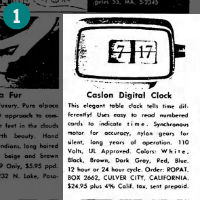
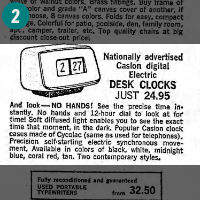
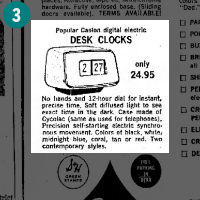
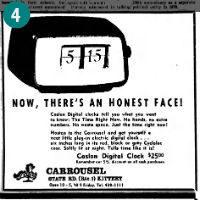
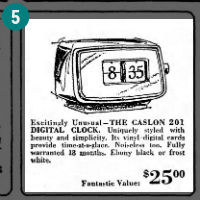
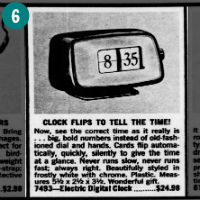
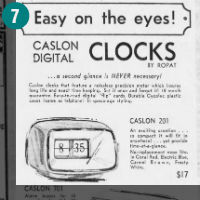
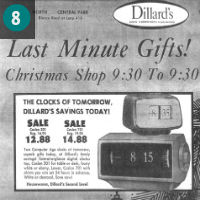
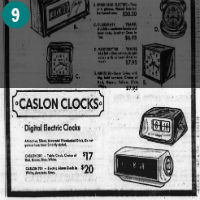
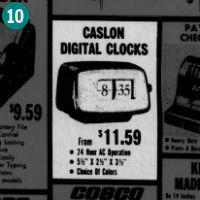
References:
1. The Los Angeles Times (Los Angeles, California), 11 Dec 1966, Sun, Page 72 [view ad]
2. The Los Angeles Times (Los Angeles, California), 19 Sep 1967, Tue, Page 36 [view ad]
3. Pasadena Independent (Pasadena, California), 05 Jun 1968, Wed, Page 3 [view ad]
4. The Portsmouth Herald (Portsmouth, New Hampshire), 03 Nov 1969, Mon, Page 23 [view ad]
5. Chicago Tribune (Chicago, Illinois), 09 Sep 1969, Tue, Page 15 [view ad]
6. Lansing State Journal (Lansing, Michigan), 06 Jul 1969, Sun, Page 106 [view ad]
7. Arizona Republic (Phoenix, Arizona), 22 Sep 1970, Tue, Page 3 [view ad]
8. San Antonio Express (San Antonio, Texas), 23 Dec 1970, Wed, Page 7 [view ad]
9. Arizona Republic (Phoenix, Arizona)31 Aug 1971, Tue, Page 10 [view ad]
10. Arizona Daily Star (Tucson, Arizona), 09 Jan 1973, Tue, Page 30 [view ad]
See forum entry to comment

